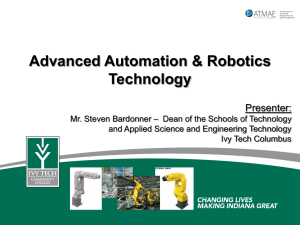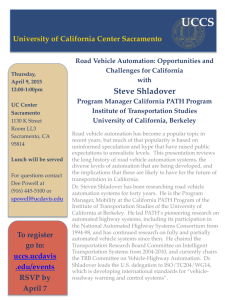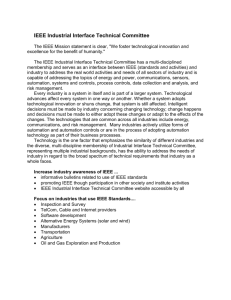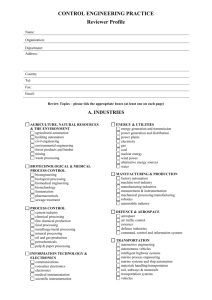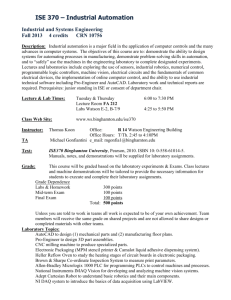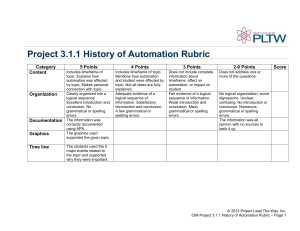Editorial - Ken Goldberg
advertisement
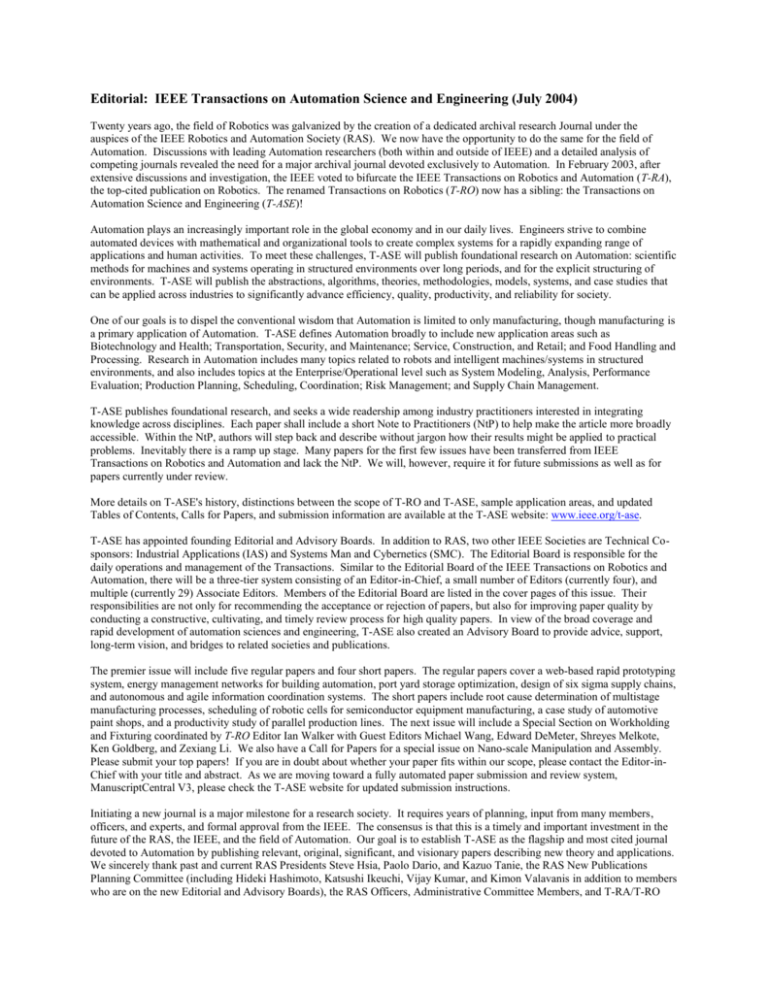
Editorial: IEEE Transactions on Automation Science and Engineering (July 2004) Twenty years ago, the field of Robotics was galvanized by the creation of a dedicated archival research Journal under the auspices of the IEEE Robotics and Automation Society (RAS). We now have the opportunity to do the same for the field of Automation. Discussions with leading Automation researchers (both within and outside of IEEE) and a detailed analysis of competing journals revealed the need for a major archival journal devoted exclusively to Automation. In February 2003, after extensive discussions and investigation, the IEEE voted to bifurcate the IEEE Transactions on Robotics and Automation (T-RA), the top-cited publication on Robotics. The renamed Transactions on Robotics (T-RO) now has a sibling: the Transactions on Automation Science and Engineering (T-ASE)! Automation plays an increasingly important role in the global economy and in our daily lives. Engineers strive to combine automated devices with mathematical and organizational tools to create complex systems for a rapidly expanding range of applications and human activities. To meet these challenges, T-ASE will publish foundational research on Automation: scientific methods for machines and systems operating in structured environments over long periods, and for the explicit structuring of environments. T-ASE will publish the abstractions, algorithms, theories, methodologies, models, systems, and case studies that can be applied across industries to significantly advance efficiency, quality, productivity, and reliability for society. One of our goals is to dispel the conventional wisdom that Automation is limited to only manufacturing, though manufacturing is a primary application of Automation. T-ASE defines Automation broadly to include new application areas such as Biotechnology and Health; Transportation, Security, and Maintenance; Service, Construction, and Retail; and Food Handling and Processing. Research in Automation includes many topics related to robots and intelligent machines/systems in structured environments, and also includes topics at the Enterprise/Operational level such as System Modeling, Analysis, Performance Evaluation; Production Planning, Scheduling, Coordination; Risk Management; and Supply Chain Management. T-ASE publishes foundational research, and seeks a wide readership among industry practitioners interested in integrating knowledge across disciplines. Each paper shall include a short Note to Practitioners (NtP) to help make the article more broadly accessible. Within the NtP, authors will step back and describe without jargon how their results might be applied to practical problems. Inevitably there is a ramp up stage. Many papers for the first few issues have been transferred from IEEE Transactions on Robotics and Automation and lack the NtP. We will, however, require it for future submissions as well as for papers currently under review. More details on T-ASE's history, distinctions between the scope of T-RO and T-ASE, sample application areas, and updated Tables of Contents, Calls for Papers, and submission information are available at the T-ASE website: www.ieee.org/t-ase. T-ASE has appointed founding Editorial and Advisory Boards. In addition to RAS, two other IEEE Societies are Technical Cosponsors: Industrial Applications (IAS) and Systems Man and Cybernetics (SMC). The Editorial Board is responsible for the daily operations and management of the Transactions. Similar to the Editorial Board of the IEEE Transactions on Robotics and Automation, there will be a three-tier system consisting of an Editor-in-Chief, a small number of Editors (currently four), and multiple (currently 29) Associate Editors. Members of the Editorial Board are listed in the cover pages of this issue. Their responsibilities are not only for recommending the acceptance or rejection of papers, but also for improving paper quality by conducting a constructive, cultivating, and timely review process for high quality papers. In view of the broad coverage and rapid development of automation sciences and engineering, T-ASE also created an Advisory Board to provide advice, support, long-term vision, and bridges to related societies and publications. The premier issue will include five regular papers and four short papers. The regular papers cover a web-based rapid prototyping system, energy management networks for building automation, port yard storage optimization, design of six sigma supply chains, and autonomous and agile information coordination systems. The short papers include root cause determination of multistage manufacturing processes, scheduling of robotic cells for semiconductor equipment manufacturing, a case study of automotive paint shops, and a productivity study of parallel production lines. The next issue will include a Special Section on Workholding and Fixturing coordinated by T-RO Editor Ian Walker with Guest Editors Michael Wang, Edward DeMeter, Shreyes Melkote, Ken Goldberg, and Zexiang Li. We also have a Call for Papers for a special issue on Nano-scale Manipulation and Assembly. Please submit your top papers! If you are in doubt about whether your paper fits within our scope, please contact the Editor-inChief with your title and abstract. As we are moving toward a fully automated paper submission and review system, ManuscriptCentral V3, please check the T-ASE website for updated submission instructions. Initiating a new journal is a major milestone for a research society. It requires years of planning, input from many members, officers, and experts, and formal approval from the IEEE. The consensus is that this is a timely and important investment in the future of the RAS, the IEEE, and the field of Automation. Our goal is to establish T-ASE as the flagship and most cited journal devoted to Automation by publishing relevant, original, significant, and visionary papers describing new theory and applications. We sincerely thank past and current RAS Presidents Steve Hsia, Paolo Dario, and Kazuo Tanie, the RAS New Publications Planning Committee (including Hideki Hashimoto, Katsushi Ikeuchi, Vijay Kumar, and Kimon Valavanis in addition to members who are on the new Editorial and Advisory Boards), the RAS Officers, Administrative Committee Members, and T-RA/T-RO Editor-in-Chief Alessandro De Luca for their vision, efforts and strong support. To catalyze research in the field of Automation, we now ask for your support: please subscribe, submit, review, cite, and recommend T-ASE to your colleagues! Peter B. Luh Editor-in-Chief, IEEE T-ASE SNET Prof. of Communications & Information Technology University of Connecticut Dept. of Elec. & Comp. Eng. Ken Goldberg Chair, T-ASE Advisory Board University of California Industrial Eng. & Operations Research Electrical Eng. & Computer Science Berkeley, CA 94720-1777 Richard Volz Ex-VP for Publications and President Elect, IEEE Robotics and Automation Society Royce E. Wisenbaker Prof. of Eng. Texas A&M University Dept. of Computer Science Sample Automation Presented at ICRA 2004: Topics -/Nano-devices for Controlled Drug Delivery c Algorithm Based Area Coverage Approach for Controlled Drug Delivery Using Micro-Robots for Vertical Type Air Conditioning Duct Applications to Construction Environments Apple Picking Robot Automation: Transportation Operating on Ships Roadway Crack Tracking Mobile Robot with Force Regulation Large Object - Development of an Industrial Application -Board Vision System for Lane Recognition and Front-Vehicle Detection to Enhance Driver's Awareness -Functional Service Robots Using Tripodal Schematic Control Architecture for the Elderly and the Motor-Impaired in a Robotic Rehabilitation Environment Indoor Service Robots in Large-Scale Environments Automation: Biology Multi-Fingered Robotic Hand for the Indoor Service Robot tion of Membrane Proteins by Robot with Soft Coordinate Measuring -Liter Bio-Material Spotting System for Bio-Chip Micorarray Fabrication Robot PSR Automation: Mine Mapping/Excavation Proteins in Crystallization Autonomous Mine Mapping -time Soil Parameter Identification Scheme for Autonomous Excavation Moving Droplets In Automation of Yeast Pedigree Analysis Autonomous Vehicle for a Mining Task Automation: Monitoring Mapping On-line Monitoring and Diagnosis System Automation: Demining - tracking Automation: Cleaning, Construction, Agriculture Robots Hazardous Area Activities Using a Multi-Robot System Mobile Robot -inspired Robots for Environmental Monitoring -servicesbased Remote Monitoring and Control Architecture Demining Slave Hand for Demining Operation Automation: Systems Automation: Security/Surveillance Control Reinforcement Learning Based Sensor Dispatching ystem for Airborne Surveillance Modular Systems -Reconfigurable for Asteroid Surface Exploration with an Autonomous Mobile Platform Range Image Technology Coverage-Resolution for Automated Satellite Frame Selection Automation: Manufacturing Systems -line Monitoring and Diagnosis System in Manufacturing Automation Stops Manufacturing Systems rol Programs for Efficient Handling of Errors in Flexible Manufacturing Cells Automation: Inspection nt of a Robot for the Detection of Plastic Dangerous Objects for Payload Transportation by a System of Mobile Manipulators Automated Inspection of Bores at Low Volume High Variant Parts Automation: Medical Applications Sewer Inspection Interactive Needle Insertions in 3D NonLinear Material Speed Automatic Object Identification Using Passive RFID Technology Disabilities Using Hidden Markov Model Based Skill Learning ANN and Laser Data Fusion Product Manufacturing System with Split and Merge - Automation: Service Automation Supply Chains Method for Strategic Sourcing and Inventory Replenishment System for Several Companies Using a New Augmented Lagrangian Relaxation

